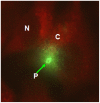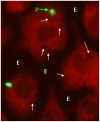Establishment of an in vitro assay for assessing the effects of drugs on the liver stages of Plasmodium vivax malaria
- PMID: 21151554
- PMCID: PMC3000326
- DOI: 10.1371/journal.pone.0014275
Establishment of an in vitro assay for assessing the effects of drugs on the liver stages of Plasmodium vivax malaria
Abstract
Plasmodium vivax (Pv) is the second most important human malaria parasite. Recent data indicate that the impact of Pv malaria on the health and economies of the developing world has been dramatically underestimated. Pv has a unique feature in its life cycle. Uninucleate sporozoites (spz), after invasion of human hepatocytes, either proceed to develop into tens of thousands of merozoites within the infected hepatocytes or remain as dormant forms called hypnozoites, which cause relapses of malaria months to several years after the primary infection. Elimination of malaria caused by Pv will be facilitated by developing a safe, highly effective drug that eliminates Pv liver stages, including hypnozoites. Identification and development of such a drug would be facilitated by the development of a medium to high throughput assay for screening drugs against Pv liver stages. We undertook the present pilot study to (1) assess the feasibility of producing large quantities of purified, vialed, cryopreserved Pv sporozoites and (2) establish a system for culturing the liver stages of Pv in order to assess the effects of drugs on the liver stages of Pv. We used primaquine (PQ) to establish this assay model, because PQ is the only licensed drug known to clear all Pv hepatocyte stages, including hypnozoites, and the effect of PQ on Pv hepatocyte stage development in vitro has not previously been reported. We report that we have established the capacity to reproducibly infect hepatoma cells with purified, cyropreserved Pv spz from the same lot, quantitate the primary outcome variable of infected hepatoma cells and demonstrate the inhibitory activity of primaquine on the infected hepatoma cells. We have also identified small parasite forms that may be hypnozoites. These data provide the foundation for finalizing a medium throughput, high content assay to identify new drugs for the elimination of all Pv liver stages.
Conflict of interest statement
Figures






References
-
- Mendis K, Sina BJ, Marchesini P, Carter R. The neglected burden of Plasmodium vivax malaria. Am J Trop Med Hyg. 2001;64(Suppl 1–2):97–106. - PubMed
-
- Sina B. Focus on Plasmodium vivax. Trends Parasitol. 2002;18:287–289. - PubMed
-
- WHO. World Malaria Report. 2008.
-
- Kochar DK, Das A, Kochar SK, Saxena V, Sirohi P, et al. Severe Plasmodium vivax malaria: a report on serial cases from Bikaner in northwestern India. Am J Trop Med Hyg. 2009;80:194–198. - PubMed
Publication types
MeSH terms
Substances
LinkOut - more resources
Full Text Sources
Other Literature Sources

